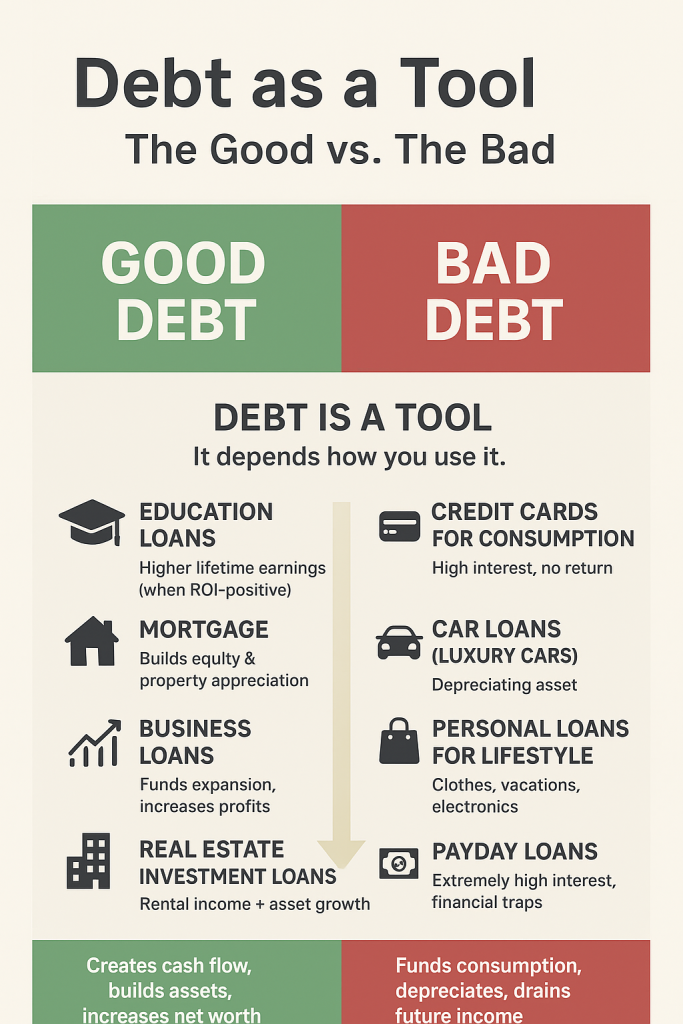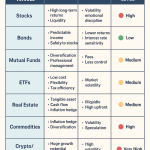Introduction
Debt as a tool can change the way you think about borrowing, money, and financial freedom. For many, the word “debt” sparks fear—images of overdue bills, rising interest rates, and overwhelming credit card balances. But here’s the truth: debt is not inherently bad. In fact, when used strategically, debt can be one of the most powerful financial tools you’ll ever have. Whether you’re an individual looking to invest in your future, a student financing higher education, or a business owner scaling operations, understanding how to use debt as a tool can unlock doors that cash alone cannot.
In this ultimate guide, we’ll explore what makes debt dangerous, what makes it beneficial, and how you can turn it into a wealth-building engine instead of a burden.
Table of Contents
- What Does It Mean to Use Debt as a Tool?
- The Psychology of Debt: Why We Fear It
- The Two Faces of Debt: Good Debt vs. Bad Debt
- Why the Wealthy Embrace Debt
- How Businesses Use Debt to Grow
- Debt and Higher Education: Investment or Trap?
- Real Estate: The Classic Example of Debt as a Tool
- Debt in the Stock Market: Margin and Leverage Explained
- Government Debt: Lessons from Nations
- The Dangers of Misusing Debt
- Strategies for Using Debt Responsibly
- Debt and Financial Freedom: Can Borrowing Make You Richer?
- Studies on Debt and Wealth Creation
- Case Studies of Smart Debt Use
- How to Build Your Own Debt Strategy
- Tools and Resources to Manage Debt Effectively
- Common Myths About Debt
- Future of Debt: AI, Fintech, and New Borrowing Models
- Action Plan: Turning Debt Into a Wealth-Building Tool
- Conclusion: Redefining Debt in Your Life
1. What Does It Mean to Use Debt as a Tool?
When you think of tools, you imagine a hammer, a laptop, or even a car. Tools help you achieve a task faster or more efficiently. Debt, when framed correctly, works the same way. It gives you leverage—the ability to use borrowed money to achieve something you couldn’t do with your own resources alone.
Think about it this way:
- A $200,000 house may take decades to save for in cash.
- But with debt (a mortgage), you can own it today, live in it, and build equity as its value grows.
That’s debt as a tool.
2. The Psychology of Debt: Why We Fear It
Debt often carries a negative stigma. Psychologists argue that humans experience debt stress—a chronic burden that weighs on mental health. A 2021 study from the American Psychological Association found that 65% of adults list money and debt as their top stressors.
The fear stems from lack of control. When payments stack up and interest compounds, debt feels like a trap. But when approached with knowledge and strategy, debt can flip from being stressful to being empowering.
3. The Two Faces of Debt: Good Debt vs. Bad Debt
Not all debt is created equal. Financial experts like Robert Kiyosaki (Rich Dad Poor Dad) emphasize that debt can be categorized into:
- Good Debt: Helps you generate income, build assets, or increase value. Example: student loans for a profitable career, business loans, or mortgages on appreciating property.
- Bad Debt: Funds consumption without return. Example: credit card debt for vacations, luxury clothes, or items that depreciate.
The secret lies in recognizing the difference.
4. Why the Wealthy Embrace Debt
It’s no secret: billionaires and corporations use debt strategically. According to a 2022 Bloomberg Wealth report, many ultra-wealthy families borrow at low interest rates against their investments instead of selling assets—avoiding capital gains tax while maintaining liquidity.
Debt allows the wealthy to:
- Keep money invested while still accessing cash.
- Scale investments faster than saving alone.
- Hedge against inflation by locking in low borrowing rates.
Debt, for them, is not scary. It’s leverage.
5. How Businesses Use Debt to Grow
Every major business you know has used debt as a tool. Apple, Amazon, Tesla—all raised billions in debt at various points to expand operations.
Why businesses love debt:
- It allows rapid scaling.
- Interest payments are often tax-deductible.
- It avoids diluting ownership compared to equity financing.
Without debt financing, many of today’s largest companies wouldn’t exist.
6. Debt and Higher Education: Investment or Trap?
Student debt sparks heated debate. In the U.S., 43 million Americans owe $1.6 trillion in student loans. But is this always bad?
Studies from Georgetown University’s Center on Education and the Workforce show that bachelor’s degree holders earn 84% more over a lifetime than high school graduates.
The key: choosing a degree with high ROI.
- Engineering? Likely worth it.
- Certain liberal arts degrees with limited job prospects? More risky.
Debt for education can be a powerful tool—but only when matched with strategic career planning.
7. Real Estate: The Classic Example of Debt as a Tool
Real estate is perhaps the most famous example of debt building wealth. Mortgages enable investors to buy properties far beyond their cash savings.
Example:
- Investor A saves $200,000 and buys one property in cash.
- Investor B uses the same $200,000 as down payments on four properties, each with a mortgage.
- Over time, Investor B grows wealth faster because rent covers the debt, and appreciation multiplies across multiple assets.
This is leverage in action.
8. Debt in the Stock Market: Margin and Leverage Explained
Beyond real estate, debt also plays a role in investing. Margin accounts let investors borrow money to buy more stocks than their cash allows.
But margin comes with risk. If the market dips, losses are magnified. Studies from FINRA show that retail investors who misuse margin often lose more than they gain.
The lesson: margin is only for those with strong strategies and risk management.
9. Government Debt: Lessons from Nations
Even nations rely on debt as a tool. The U.S. national debt exceeds $34 trillion, but it funds infrastructure, defense, and social programs.
Key insights:
- Countries use debt to stimulate growth.
- Too much debt, however, risks inflation and currency devaluation.
- Japan, for example, has debt at 263% of GDP but remains stable due to high domestic ownership of bonds.
Governments remind us that debt, when managed, fuels progress.
10. The Dangers of Misusing Debt
Of course, misuse flips debt from tool to trap. Common dangers include:
- High-interest credit card balances.
- Overleveraging investments.
- Borrowing for depreciating assets.
The 2008 financial crisis was a global reminder of what happens when debt spirals out of control.
11. Strategies for Using Debt Responsibly
Here’s how to make debt your ally:
- Borrow for assets, not consumption.
- Calculate ROI before borrowing.
- Keep debt-to-income ratio under 36%.
- Lock in low, fixed interest rates.
- Always have an exit plan.
12. Debt and Financial Freedom: Can Borrowing Make You Richer?
Ironically, debt—if managed well—can fast-track financial freedom. By leveraging loans for income-generating assets, you build wealth faster than saving alone.
Example: Robert Kiyosaki’s “rich dad” principle—use other people’s money (OPM) to acquire assets that generate cash flow.
13. Studies on Debt and Wealth Creation
- A 2020 study by the Brookings Institution found that moderate student debt correlates with higher lifetime wealth.
- National Bureau of Economic Research (NBER) found that small business loans increase long-term survival rates of startups.
- Harvard Business Review revealed that companies using debt strategically outperform those that avoid it entirely.
The data is clear: debt can be productive.
14. Case Studies of Smart Debt Use
- Elon Musk leveraged debt and loans heavily in the early Tesla years.
- Warren Buffett uses debt sparingly but strategically in Berkshire Hathaway acquisitions.
- Average homeowners in the U.S. see net worth multiply by owning property through mortgages.
15. How to Build Your Own Debt Strategy
Steps:
- Identify goals (home, business, investment).
- Research loan types and rates.
- Calculate potential returns.
- Build repayment strategies.
- Diversify income to handle risk.
16. Tools and Resources to Manage Debt Effectively
- Debt calculators (NerdWallet, Bankrate).
- Books: “Rich Dad Poor Dad,” “The Millionaire Real Estate Investor.”
- Apps: Mint, YNAB, Debt Payoff Planner.
17. Common Myths About Debt
- “All debt is bad.” → False.
- “Debt means you’re poor.” → False.
- “You must be debt-free to be wealthy.” → False—most wealthy people use debt strategically.
18. Future of Debt: AI, Fintech, and New Borrowing Models
The rise of fintech lending platforms, AI-driven credit scoring, and blockchain-based decentralized finance (DeFi) is reshaping debt. These tools could make borrowing more efficient and transparent, giving individuals more control.
19. Action Plan: Turning Debt Into a Wealth-Building Tool
- Shift mindset: debt is neutral—it’s how you use it.
- Educate yourself on good vs. bad debt.
- Start small: leverage debt in one area (e.g., property or education).
- Monitor ROI regularly.
- Adjust as needed to avoid overleveraging.
20. Conclusion: Redefining Debt in Your Life
Debt as a tool is a mindset shift. Instead of seeing it as a chain, view it as leverage—a financial lever that multiplies opportunities when handled with discipline. From homes to businesses, from education to investments, debt has powered some of the greatest wealth-building stories in history.
The question is not whether debt is good or bad—it’s whether you know how to use it.



